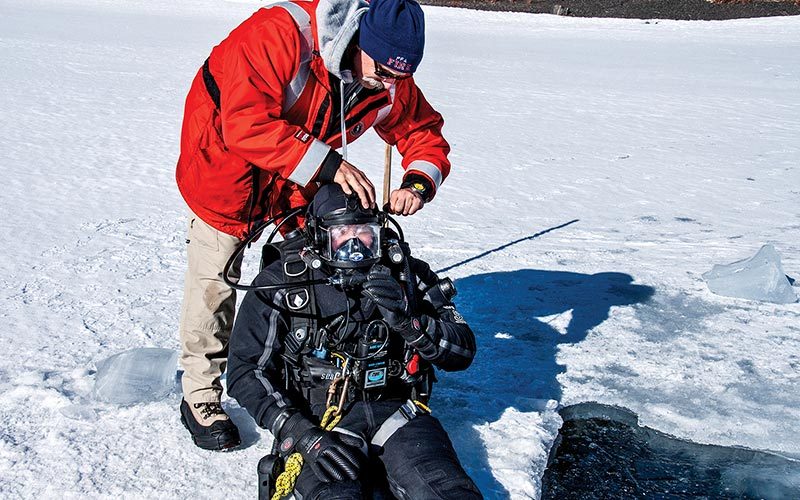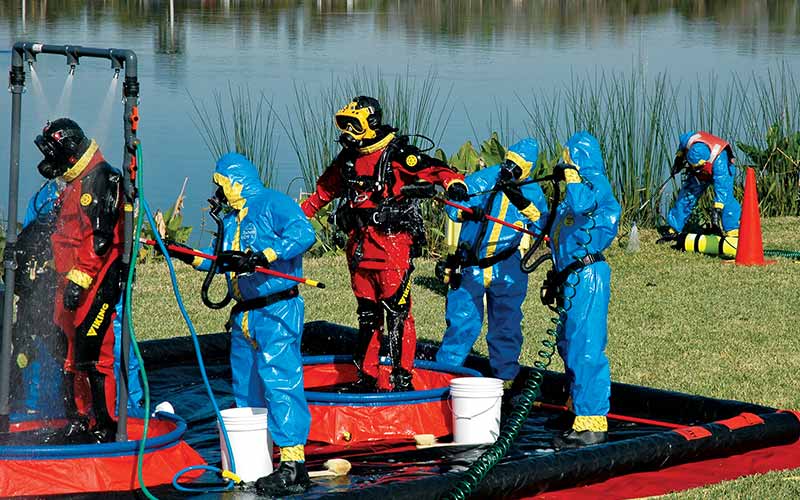Time: 0400 hours (4 a.m.)
Place: Quad Cities, Iowa/Illinois, on the Mississippi River
Date: Dec. 15, 2012

The iPhone’s sonar tone rings out. Groggily, the volunteer diver for Big River Rescue answers. Police chief Mark Poulous, himself a volunteer and a dive instructor, gives the brief.
Police found a car with its lights on in the main channel of the Mississippi River; the lights are now out. No stolen vehicles have been reported. The veteran officer on the scene, diver and former marine Steve W., could not deploy for lack of equipment and called for backup. The Moline (Ill.) Fire Department responded with a boat team but pulled it off the water because of dangerous wind, icing and current. The dive team is needed.
The diver responds. The team rallies at the incident command center before sunrise. There are no witnesses. The car is marked with a single buoy 40 feet from shore in 12 feet of water. Nobody knows if a victim or victims are inside the car. There is no ambient light. The air temperature is 18°F, the wind is out of the west, and a 4-knot current is running from the east, creating countercurrent chop. The water temperature is 36°F. At least the fast current and chop have prevented ice from forming on the river.
Would you respond?
If this is your idea of a great dive, welcome to the world of public safety diving (PSD). Team members may be paid firefighters, lifeguards, law-enforcement officers or emergency medical services (EMS) personnel, or they may be unpaid volunteers. Regardless, these divers routinely go into harm’s way in one of the most dangerous, underappreciated and challenging occupations in diving.
Most people aren’t even aware of PSD operations; when teams are in action they’re usually out of sight. But if you live around water there is probably a team on standby for you.
The breadth of missions undertaken by public safety divers is truly astounding. An incomplete list includes rescue, victim recovery and identification, crime scene investigation, weapons recovery, bomb disposal, port security and accident investigation. These missions occur at all hours and in all conditions — in polluted harbors, high mountain lakes, icy rivers and sweltering, alligator-filled swamps.
Getting the Job
Whether paid or unpaid, all team members are volunteers. Generally, placements on teams are coveted, so standards are high. Failure to maintain fitness and skills usually means getting “beached” and if unremediated, reassigned. Physical and emotional resilience are hallmarks of public safety divers.
Physical Fitness
In recreational diving, a well-planned and -executed dive should require only minimal to moderate exertion. In public safety diving, however, it’s usually not that simple. Routine stressors include ponderous and inflexible hazmat drysuits and frequent retrieval of heavy objects. Full face masks with communications umbilicals to topside dive supervisors are often employed, and extra heavy weight belts are used to counteract fast currents.
Recognizing the role of these factors, many teams demand comprehensive swim tests and regular swim training. The International Association of Dive Rescue Specialists (IADRS) developed a watermanship test specifically for public safety divers. The U.S. Army Combat Diver Qualification Course also contributed; the standards developed closely follow the entry guidelines for U.S. Department of Defense Special Operations Forces.

Emotional Resilience
The psychological stressors in public safety diving can be immense. Visibility is zero a lot of the time; much is done by touch alone. It is usually uncomfortably cold or hot. Divers work alone and are tethered to the surface where a standby diver is ready to deploy instantly. (This decreases the likelihood of the two divers becoming entangled, a possibly fatal problem.) Hardwire communications may fail, necessitating the use of rope pulls for signaling. Body retrieval is routine, and taking a child from a vehicle is traumatic. Taking care to avoid spoiling evidence at crime scenes is essential. These are special operations in which the ability to stay cool is critical.
The Clock is Ticking
Regardless of the weather, time of day or level of fatigue, all calls must get a response. Rescues are obviously time sensitive; survival may be prolonged when the water is cold. Crime scene evidence is perishable, and bodies even more so. Time constraints contribute to “human factors” failures, which is psychology speak for mental lapses. This is a huge concern, appreciated in aviation, surgery and nuclear power as well as in public safety diving.

Lessons for Every Diver
Public safety diving has its roots in the earliest days of diving. Diving enthusiasts in agencies and departments recognized the need and started conducting missions, usually without formal training and with their own equipment. As mission complexity increased, so did the risks to the divers. As this problem became apparent, Dive Rescue International (DRI) was founded in 1977. Dedicated specifically to the health and safety of public safety dive teams, DRI developed public safety diver training programs and began collecting information about public safety diver fatalities. From this database of the hardest lessons learned, DRI developed industry standards and principles of safety all divers can apply.
Lesson One: Fundamental skills must be mastered.
All DRI instructors are employed as public safety divers, and most are dive instructors for civilian training agencies. They are law-enforcement officers and firefighters from around the country with varied backgrounds and skills. Instructor school is a weeklong boot camp, and the first day involves five hours in the water, swimming. Next the academics start, and then the diving. Swim-test standards are higher than basic PSD standards, and there are no do-overs. Once their training is complete, the instructors teach specialty courses depending on their skill set (e.g., ice diving, hazardous materials or drysuits).
Lesson Two: Train like it matters, because it does.
High-fidelity training is essential. Elite FBI Underwater Search and Evidence Response Team training, for example, includes simulations of divers trapped under ice. Every step of the simulated emergency is treated as if it were real: Divers conduct under-ice sweeps, tow the “victim” back to the egress hole and extract him. After the “rescue,” the dive team and paramedics evaluate and evacuate the victim just as they would in a real emergency. Train hard, and train often.

Lesson Three: Safety can be practiced, just like skills.
Safety is a culture. It starts with training and is implemented in the details. For example, dive supervisors and other topside personnel who are not diving always wear personal flotation devices (PFDs) during on-water operations. It does not matter that the water is warm or calm or that each person is a strong swimmer. Emergencies happen, operational necessities change and nobody is immune to accidents. Everybody follows safe standards, every day. Poor safety compliance is a ticket to “the beach.”
Lesson Four: Incorporate human-factors training on a regular basis by training for worst-case problems.
Equipment standardization is essential. In a black-water emergency, there is no time to fumble with equipment. To the extent possible, all team members wear identical equipment with multiple cutting tools in the same places to assist in emergency egress of victims or rescuers. Standardized placement and training are meant to mitigate the inevitable perceptual narrowing that comes with the onset of stress-panic. For this reason, the Public Safety Diver Survival program taught by DRI is highly requested among client agencies.
In consultation with the police investigation team, the dive team agrees that if a victim is in the car, he will be left in place to assist in accident reconstruction. The fire department places ladders and dive tenders along the icy rocks to assist the team into the water. At first usable light (0735, or 7:35 a.m.), the primary diver enters the water. The vehicle is located upstream from the marker, and the standby diver assists with the securing of the vehicle. After they place a reinforced tow strap around the back axle, the divers go to the water’s edge, and the tow truck begins its work. By 0755 the car is on dry land, and dive operations are secured. The accident team begins its work with the medical examiner. After 20 minutes of teamwork in deadly cold water, freezing air and treacherous conditions with no mishaps, training and planning once again proved their worth in this mission’s success.
The term “public safety diving” sounds innocuous, but the diving is anything but that. The divers are rarely acknowledged, but all communities should admire their dedication and be thankful for their skills.
© Alert Diver — Q3 Summer 2013